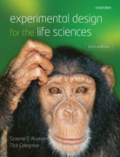
At the core of good research lies the careful design of experiments. Yet all too often a successful design comes only after a painful trial-and-error process, wasting valuable time and valuable resources. "Experimental Design for theLife Sciences" teaches the reader how to effectively design experiments, to ensure that today's students are equipped with the skills they need to be the researchers of tomorrow. With a refreshingly approachable and articulate style,the book explains the essential elements of experimental design in clear, practical terms, so that the reader can grasp and apply even the most challengingconcepts, including power analysis and pseudoreplication. Emphasising throughout the inter-relatedness of experimental design, statistics, and ethical considerations, the book ensures that the reader really understands experimental design in the broader context of biological research, using examples drawn froma range of fields across the biosciences to show to the student how the theory is applied in active research.Above all, "Experimental Design for the Life Sciences" shows how good experimental design is about clear thinking and biological understanding, not mathematical or statistical complexity - putting it atthe heart of any biosciences student's education. The companion web site features: for lecturers - figures from the book available to download, to facilitate lecture preparation; and for students and lecturers - discussion forum, promoting the discussion of experimental design in real research, to stimulate active learning on the part of the student. INDICE: PREFACE - HOW TO USE THIS BOOK; 1. Why care about design?; 2. Starting with a well defined question; 3. Between-individual variation, replication and sampling; 4. Different experimental designs; 5. Taking measurements; 6. Final thoughts; BIBLIOGRAPHY
- ISBN: 978-0-19-956912-0
- Editorial: Oxford University Press
- Encuadernacion: Rústica
- Páginas: 162
- Fecha Publicación: 01/12/2010
- Nº Volúmenes: 1
- Idioma: Inglés
